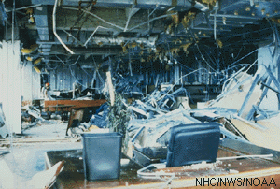
This is a photo of an office area in total disarray. The wall and ceiling coverings have been blown away exposing a tangled mess of wires and ductwork. What may have been cubicle walls now looks like a mangled pile of debris in the center of the room. Wires, broken glass, trash, and hunks of loose insulation are littered everywhere. One empty plastic trash basket stands in the foreground, perhaps ready for the start of a huge cleanup job.
This map shows a hurricane centered at -90 degrees longitude and 26 degrees north latitude in the Gulf of Mexico. A highlighted oval over the central part of the storm is labeled "Hurricane strength winds." A much larger highlighted oval surrounds the hurricane, reaching far north into southern Louisiana. This larger oval is labeled "Tropical storm strength winds."
A 2-by-4 piece of wood and a sheet of plywood are shown on a dark background.
This is a photo of a palm tree trunk with a large chunk of plywood in it. The plywood has split the trunk and gone halfway through the tree.
This photo shows a palm tree with a 2-by-4 board punched straight through the tree trunk and sticking half way out the other side.
A cartoon picture of a wave crashing on a sandy beach.
Photo of two ships stranded high and dry on a highway next to the water.
Cartoon pictures of two beaches. The first has very shallow water that deepens gradually. The second has a steep dropoff and deeper water close to shore.
Cartoon drawing of a beach house getting smashed by waves. There are four markers:
- Mean sea level (MSL), well below the house.
- Normal high tide, 0.6 meters (2 feet) above mean sea level.
- Storm surge, 4.6 meters (15 feet) above mean sea level.
- Storm tide.
Photo of a beachfront apartment building that has broken in half. Part of the building has fallen down an embankment and teeters over the water. The reason it broke apart is that the sand underneath it was washed away by a hurricane's storm waves.
Aerial photo of a flooded town. Muddy water covers the ground everywhere between treetops, rooftops, and the tops of cars.
Satellite image shows a gigantic swirling hurricane with a well-defined eye centered along the coast of North Carolina. This was Hurricane Floyd, which produced devastating floods.
Aerial photo of a flooded town in North Carolina. Rooftops, treetops, lamp posts, and power lines are visible above the waterline.
Photo of destruction caused by a hurricane-spawned tornado. In the foreground, a car sits crushed under debris. In the background, remains of houses stand amidst a huge disorganized mess of lumber and debris.
Photo of destruction caused by tornadoes embedded in Hurricane Andrew. The remains of several houses are scattered in total disarray over the lawns and streets of what had been a quiet residential neighborhood.